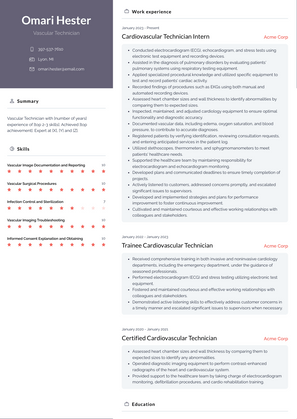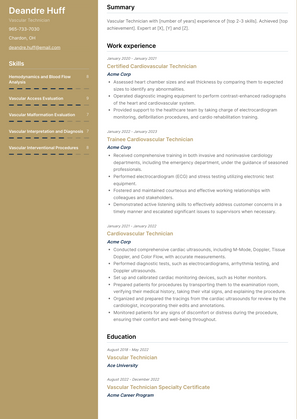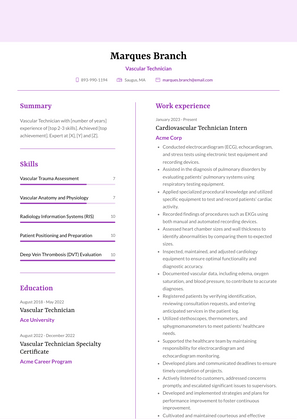Vascular Technician Resume Examples and Templates
This page provides you with Vascular Technician resume samples to use to create your own resume with our easy-to-use resume builder. Below you'll find our how-to section that will guide you through each section of a Vascular Technician resume.



What Do Hiring Managers Look for in a Vascular Technician Resume
- Proficient in performing non-invasive vascular diagnostic procedures, including ultrasound imaging, to evaluate and assess blood vessels and circulation.
- Strong knowledge of vascular anatomy and physiology to accurately interpret ultrasound images and identify abnormalities or pathologies.
- Skilled in using ultrasound equipment and associated technologies to capture and analyze vascular images and measurements.
- Adherence to safety protocols and infection control measures to ensure patient safety during procedures.
- Excellent communication and interpersonal skills to effectively interact with patients, explaining procedures, addressing concerns, and providing clear instructions.
- Proficient in documenting and maintaining accurate patient records, including procedure findings and measurements.
- Collaborates with healthcare professionals, including vascular surgeons and physicians, to assist in diagnosis and treatment planning.
- Continuous learning and staying updated with advancements in vascular imaging techniques and equipment to provide the highest quality of patient care.
- Commitment to professionalism, ethics, and patient confidentiality in all aspects of work.
How to Write a Vascular Technician Resume?
To write a professional Vascular Technician resume, follow these steps:
- Select the right Vascular Technician resume template.
- Write a professional summary at the top explaining your Vascular Technician’s experience and achievements.
- Follow the STAR method while writing your Vascular Technician resume’s work experience. Show what you were responsible for and what you achieved as a Vascular Technician.
- List your top Vascular Technician skills in a separate skills section.
How to Write Your Vascular Technician Resume Header?
Write the perfect Vascular Technician resume header by:
- Adding your full name at the top of the header.
- Add a photo to your resume if you are applying for jobs outside of the US. For applying to jobs within the US, avoid adding photo to your resume header.
- Add your current Vascular Technician job title to the header to show relevance.
- Add your current city, your phone number and a professional email address.
- Finally, add a link to your portfolio to the Vascular Technician resume header. If there’s no portfolio link to add, consider adding a link to your LinkedIn profile instead.
Bad Vascular Technician Resume Example - Header Section
Deandre 90 Foster Ave. Peabody, MA 01960 Marital Status: Married, email: cooldude2022@gmail.com
Good Vascular Technician Resume Example - Header Section
Deandre Huff, Peabody, MA, Phone number: +1-555-555-5555, Link: linkedin/in/johndoe
Make sure to add a professional looking email address while writing your resume header. Let’s assume your name is John Doe - here is a formula you can use to create email addresses:
- firstnamelastname@email.com - johndoe@email.com
- firstname.lastname@email.com - john.doe@email.com
- lastname.firstname@email.com - doe.john@email.com
- f.lastname@email.com - j.doe@email.com
- l.firstname@email.com - d.john@email.com
- firstnamelastname12@email.com - johndoe12@email.com
For a Vascular Technician email, we recommend you either go with a custom domain name (john@johndoe.com) or select a very reputed email provider (Gmail or Outlook).
How to Write a Professional Vascular Technician Resume Summary?
Use this template to write the best Vascular Technician resume summary: Vascular Technician with [number of years] experience of [top 2-3 skills]. Achieved [top achievement]. Expert at [X], [Y] and [Z].
How to Write a Vascular Technician Resume Experience Section?
Here’s how you can write a job winning Vascular Technician resume experience section:
- Write your Vascular Technician work experience in a reverse chronological order.
- Use bullets instead of paragraphs to explain your Vascular Technician work experience.
- While describing your work experience focus on highlighting what you did and the impact you made (you can use numbers to describe your success as a Vascular Technician).
- Use action verbs in your bullet points.
Cardiovascular Technician Intern Resume Example
Cardiovascular Technician Intern
- Conducted electrocardiogram (ECG), echocardiogram, and stress tests using electronic test equipment and recording devices.
- Assisted in the diagnosis of pulmonary disorders by evaluating patients' pulmonary systems using respiratory testing equipment.
- Applied specialized procedural knowledge and utilized specific equipment to test and record patients' cardiac activity.
- Recorded findings of procedures such as EKGs using both manual and automated recording devices.
- Assessed heart chamber sizes and wall thickness to identify abnormalities by comparing them to expected sizes.
- Inspected, maintained, and adjusted cardiology equipment to ensure optimal functionality and diagnostic accuracy.
- Documented vascular data, including edema, oxygen saturation, and blood pressure, to contribute to accurate diagnoses.
- Registered patients by verifying identification, reviewing consultation requests, and entering anticipated services in the patient log.
- Utilized stethoscopes, thermometers, and sphygmomanometers to meet patients' healthcare needs.
- Supported the healthcare team by maintaining responsibility for electrocardiogram and echocardiogram monitoring.
- Developed plans and communicated deadlines to ensure timely completion of projects.
- Actively listened to customers, addressed concerns promptly, and escalated significant issues to supervisors.
- Developed and implemented strategies and plans for performance improvement to foster continuous improvement.
- Cultivated and maintained courteous and effective working relationships with colleagues and stakeholders.
Trainee Cardiovascular Technician Resume Example
Trainee Cardiovascular Technician
- Received comprehensive training in both invasive and noninvasive cardiology departments, including the emergency department, under the guidance of seasoned professionals.
- Performed electrocardiogram (ECG) and stress testing utilizing electronic test equipment.
- Fostered and maintained courteous and effective working relationships with colleagues and stakeholders.
- Demonstrated active listening skills to effectively address customer concerns in a timely manner and escalated significant issues to supervisors when necessary.
Cardiovascular Technician Resume Example
Cardiovascular Technician
- Conducted comprehensive cardiac ultrasounds, including M-Mode, Doppler, Tissue Doppler, and Color Flow, with accurate measurements.
- Performed diagnostic tests, such as electrocardiograms, arrhythmia testing, and Doppler ultrasounds.
- Set up and calibrated cardiac monitoring devices, such as Holter monitors.
- Prepared patients for procedures by transporting them to the examination room, verifying their medical history, taking their vital signs, and explaining the procedure.
- Organized and prepared the tracings from the cardiac ultrasounds for review by the cardiologist, incorporating their edits and annotations.
- Monitored patients for any signs of discomfort or distress during the procedure, ensuring their comfort and well-being throughout.
Certified Cardiovascular Technician Resume Example
Certified Cardiovascular Technician
- Assessed heart chamber sizes and wall thickness by comparing them to expected sizes to identify any abnormalities.
- Operated diagnostic imaging equipment to perform contrast-enhanced radiographs of the heart and cardiovascular system.
- Provided support to the healthcare team by taking charge of electrocardiogram monitoring, defibrillation procedures, and cardio rehabilitation training.
Top Vascular Technician Resume Skills for 2023
- Vascular Ultrasound Imaging
- Doppler Ultrasound Techniques
- Venous and Arterial Doppler Studies
- Carotid Doppler Studies
- Abdominal Vascular Imaging
- Peripheral Arterial Studies
- Venous Insufficiency Studies
- Deep Vein Thrombosis (DVT) Evaluation
- Vascular Anatomy and Physiology
- Hemodynamics and Blood Flow Analysis
- Vascular Interpretation and Diagnosis
- Vascular Disease Assessment
- Vascular Malformation Evaluation
- Vascular Access Evaluation
- Vascular Interventional Procedures
- Vascular Sonography Equipment Operation
- Image Optimization and Enhancement
- Vascular Imaging Protocol Development
- Patient Positioning and Preparation
- Vascular Image Documentation and Reporting
- Vascular Image Analysis and Measurements
- Vascular Imaging Quality Assurance
- Vascular Lab Accreditation Compliance
- Vascular Lab Workflow and Efficiency Optimization
- Vascular Imaging Troubleshooting
- Informed Consent Explanation and Obtaining
- Patient Education on Vascular Examinations
- Medical Terminology and Anatomy
- Vascular Disease Management
- Vascular Surgical Procedures
- Vascular Imaging Data Management
- Vascular Imaging Research Methods
- Vascular Interventional Radiology
- Vascular Trauma Assessment
- Vascular Imaging Software Utilization
- Vascular Laboratory Safety Protocols
- Patient Care and Comfort during Procedures
- Infection Control and Sterilization
- Radiology Information Systems (RIS)
- Picture Archiving and Communication Systems (PACS)
- Interpreting Medical Orders and Physician Notes
- Collaboration with Radiologists and Physicians
- Patient Confidentiality and HIPAA Compliance
- Vascular Laboratory Equipment Maintenance
How Long Should my Vascular Technician Resume be?
Your Vascular Technician resume length should be less than one or two pages maximum. Unless you have more than 25 years of experience, any resume that’s more than two pages would appear to be too long and risk getting rejected.
On an average, for Vascular Technician, we see most resumes have a length of 2. And, that’s why we advise you to keep the resume length appropriate to not get rejected.
Copyright ©2025 Workstory Inc.
